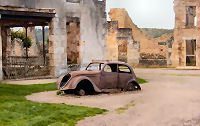Introduction to Oradour-sur-Glane 10th June 1944
This website is about a massacre and war crime that took place during World War II, in the village of Oradour-sur-Glane, in the Haute-Vienne department of France, starting at about 14:00, on Saturday 10th of June 1944. The village had been far from any centre of conflict, was not, nor had ever been an active resistance stronghold. Yet on that Saturday, men from the Der Führer Regiment of the 2nd Waffen SS Panzer Division, Das Reich, drove into Oradour and killed everyone that they could find, a total of 643 men, women and children. The village was then looted and every building, set on fire. To this day there is no universally agreed explanation as to why the SS acted as they did, or why they chose Oradour for their attack. All the principal characters on the SS side are now dead and the few French survivors of the village were not given any reasons by the troops as to why they were acting as they were.
I first became interested in the story many years ago when reading Jens Kruuse's book, Madness at Oradour, but at that time I did not have a critical view of the subject and simply accepted his account as being wholly correct. It was not until I read Robin Mackness's book, Oradour Massacre and Aftermath in 1994 that I became determined to find out more about the subject. At first, my aim was simply to find some hard evidence in support of the Mackness story, which supplied, as Professor M.R.D. Foot wrote, "An awesomely simple explanation of a famous puzzle, hitherto almost totally obscure."
I admit from the outset that my account suffers from a lack of face to face interviews with any of the people involved, either French or German. It is essentially a review and re-presentation of the currently available evidence, which has been interpreted by myself in order to reach the conclusions presented in the section, In a Ruined State. As a matter of interest, I first presented my conclusions on this site under the title, An Excess of Zeal. This was itself chosen as a better descriptive replacement for my original working title of: Not as it seems. It was only after I started work that I noticed that the phrase, Excess of Zeal had been used by Max Hastings as a chapter title in his book, Das Reich. It is partly to avoid the suspicion of plagiarism that I have changed the title during this revision of my work. In a Ruined State, plays upon the state of the German and French nations both physical and moral, before, during and after the war, as well as the post war decision of the French government to preserve the ruins of Oradour, "in a ruined state" (this quotation comes from the French Minister of National Education, René Capitant in November 1944).
There is a commemorative ceremony held on the 10th June each year in Oradour-sur-Glane. Starting at 12:00 in the new village church, the celebrants then process to the Town Hall and school, before visiting the ruins, where they visit the church and finally the cemetery for a wreath-laying ceremony.
During my researches into the Oradour story, it became more and more apparent that the story was much more complex than I had at first realised. In fact as mentioned above, my original working title for the account was, Not as it seems, because that just about sums up the twists and turns unfolded by the story's end. For example, in the Centre de la Mémoire, opened in Oradour in April 1999, the authorities there attribute the massacre to a man who never existed. It does seem strange to me that in the national centre dedicated to remembering the events of 10th June 1944, they have been showing the wrong name since opening and even after being handed proof of the error by myself, seem unwilling to correct it (as of October 2019).
It is to give an account of a complex event, hopefully without errors that this website has been set up. If any reader has any hard evidence to either support or contest my version, then please contact me and I shall be pleased to acknowledge them and incorporate the new data into this site.
Finally a word about the design of this website, it is very plain, no music, no fancy graphics, no cookies, no leading edge HTML features, or other time-consuming to download features.
All links are shown in underlined blue and photographs which act as links are outlined in blue, all links should change colour to purple when 'clicked' so as to help the reader keep track of items visited.
For those who only wish to know the outline of the case, without reading all the considerable detail, there is a summary section which will give you the main facts at: Summary of: In a Ruined State; please note that as its name implies this is only a précis of the event, with much detail missing.
On to Chapter 1 of In a Ruined State
© Michael Williams: revised Sunday, 26 January 2025



